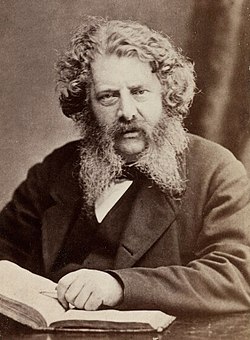Rankine scale
| Rankine | |
|---|---|
| Unit of | Temperature |
| Symbol | °R, °Ra |
| Named after | W. J. M. Rankine |
| Conversions | |
| 491.67 °R in ... | ... corresponds to ... |
| Kelvin scale | 273.15 K |
| Celsius scale | 0.00 °C |
| Fahrenheit | 32.00 °F |

The Rankine scale (/ˈræŋkɪn/ RANG-kin) is an absolute scale of thermodynamic temperature named after the University of Glasgow engineer and physicist W. J. M. Rankine, who proposed it in 1859.[1] Similar to the Kelvin scale, which was first proposed in 1848,[1] zero on the Rankine scale is absolute zero, but a temperature difference of one Rankine degree (°R or °Ra) is defined as equal to one Fahrenheit degree, rather than the Celsius degree used on the Kelvin scale. In converting from kelvin to degrees Rankine, 1 °R = 5/9 K or 1 K = 2 °R. A temperature of 0 K (−273.15 °C; −459.67 °F) is equal to 0 °R.[2][3]
Usage
[edit]The Rankine scale is used in engineering systems where heat computations are done using degrees Fahrenheit.[4][better source needed]
The symbol for degrees Rankine is °R[2] (or °Ra if necessary to distinguish it from the Rømer and Réaumur scales). By analogy with the SI unit kelvin, some authors term the unit Rankine, omitting the degree symbol.[5][6]
Some temperatures relating the Rankine scale to other temperature scales are shown in the table below.
| Scale | ||||||
|---|---|---|---|---|---|---|
| Kelvin | Rankine | Fahrenheit | Celsius | Réaumur | ||
| Temperature | Absolute zero | 0 K | 0.00 °R | −459.67 °F | −273.15 °C | −218.52 °Ré |
| Freezing point of brine[a] | 255.37 K | 459.67 °R | 0.00 °F | −17.78 °C | −14.22 °Ré | |
| Freezing point of water[b] | 273.15 K | 491.67 °R | 32.00 °F | 0.00 °C | 0 °Ré | |
| Boiling point of water[c] | 373.1339 K | 671.641 °R | 211.971 °F | 99.9839 °C | 79.9871 °Ré | |
See also
[edit]Notes
[edit]- ^ The freezing point of brine is the zero point of Fahrenheit scale, old definition.[7]
- ^ The ice point of purified water has been measured to be 0.00008910 degrees Celsius.[8]
- ^ For Vienna Standard Mean Ocean Water at one standard atmosphere (101.325 kPa) when calibrated solely per the two-point definition of thermodynamic temperature. Older definitions of the Celsius scale once defined the boiling point of water under one standard atmosphere as being precisely 100 °C. However, the current definition results in a boiling point that is actually 16.1 mK less. For more about the actual boiling point of water, see VSMOW in temperature measurement.[citation needed]
References
[edit]- ^ a b "Rankine". Merriam-Webster.com Dictionary. Merriam-Webster. Retrieved 2019-11-07.
- ^ a b Thompson, Ambler; Taylor, Barry N. (2008). "Guide for the use of the International System of Units (SI)" (PDF). NIST Special Publication. 811: 45–69. doi:10.6028/nist.sp.811e2008. Retrieved 2019-11-07.
- ^ "NIST Guide to the SI, Appendix B.8: Factors for Units Listed Alphabetically". NIST.gov. National Institute of Standards and Technology. 18 August 2025 [1 February 2016]. Retrieved 2 November 2025.
- ^ Berger, Eric (2022-08-29). "Warning sign? NASA never finished a fueling test before today's SLS launch attempt". Ars Technica.
- ^ Pauken, Michael (2011). Thermodynamics For Dummies. Indianapolis: Wiley Publishing Inc. p. 20. ISBN 978-1-118-00291-9.
- ^ Balmer, Robert (2011). Modern Engineering Thermodynamics. Oxford: Elsevier Inc. p. 10. ISBN 978-0-12-374996-3.
- ^ Grigull, Ulrich (1986). Heat Transfer (PDF). Retrieved 2022-08-29.
- ^ Magnum, B.W. (June 1995). "Reproducibility of the Temperature of the Ice Point in Routine Measurements" (PDF). NIST Technical Note. 1411. Archived from the original (PDF) on 2007-03-07. Retrieved 2007-02-11.
